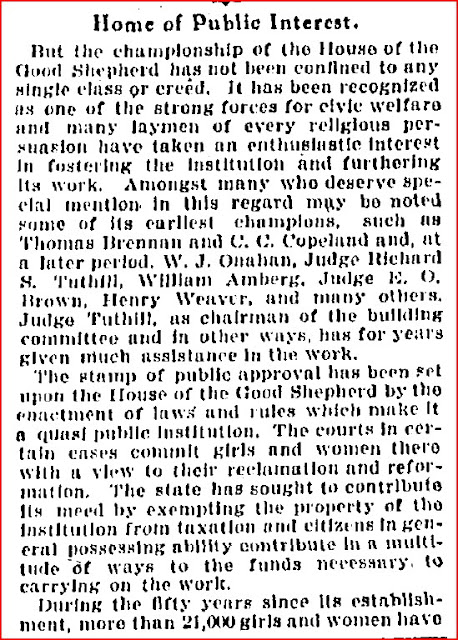 The first Chicago orphanages, the Chicago Orphan Asylum
and the Catholic Orphan Asylum, opened their doors in 1849 in the aftermath of
a cholera epidemic. By 1890, there were 12 orphanages in the city. They split
along Roman Catholic and Protestant lines. Chicago had no Jewish orphanages
until the 1890s. Until then, Jews tried to send orphans to institutions in
Cincinnati, but some Jewish orphans lived in Protestant orphanages in Chicago.
Almost all “orphans” in nineteenth-century Chicago orphanages had one parent
living. They were places that single-parent families in financial crisis could
safely keep their children. A few of them, like the Home for the Friendless,
were gigantic, housing hundreds of children at a time.
The first Chicago orphanages, the Chicago Orphan Asylum
and the Catholic Orphan Asylum, opened their doors in 1849 in the aftermath of
a cholera epidemic. By 1890, there were 12 orphanages in the city. They split
along Roman Catholic and Protestant lines. Chicago had no Jewish orphanages
until the 1890s. Until then, Jews tried to send orphans to institutions in
Cincinnati, but some Jewish orphans lived in Protestant orphanages in Chicago.
Almost all “orphans” in nineteenth-century Chicago orphanages had one parent
living. They were places that single-parent families in financial crisis could
safely keep their children. A few of them, like the Home for the Friendless,
were gigantic, housing hundreds of children at a time.During the days of the Township/City of Lake View Fullerton Avenue was the southern border with Chicago. Even though the sanitarium was located in Community of Lincoln Park I decided to included this former institution in this blog.

3212 N Evanston Avenue (Broadway) - Ebay


text - Jeff Hamrick via LakeView Historical-Facebook

NRS was established in a Wrigleyville-area storefront in
1971 to fill a need for comprehensive crisis intervention for young people in
Chicago. It was conceived as a centralized organization with free 24-hour
services, expertise in all youth-related issues and as an information
clearinghouse of youth services.
At one period the Dunkin Donuts store at the corner of
Clark St. and Belmont Ave. was ground zero for youth homelessness in Chicago.
It is still a magnet for homeless youth today.
In 1974, the agency received an eight-month federal
demonstration grant to establish a national hotline. During this time, 11,000
calls were received demonstrating the need for this type of service. They have
survived mostly on government grants since then. Beginning as the National
Runaway Switchboard, and now as National Runaway Safeline, NRS’ capabilities
and services have since grown considerably.
NRS serves as the federally designated national
communication system for runaway and homeless youth with services provided
through funding from Family and Youth Services Bureau in the Administration for
Children and Families, U.S. Dept. of Health and Human Services. They also
depend on the generosity of private, individual donors, corporate partners and
foundation grants. Their last budget showed revenue of $2.125 million.
This is a proposal to turn the Lakeview Lutheran Church,
which has a smaller congregation than in the past, into a mixed use-church and
disability accessible rental building. This development will serve residents at
or below 30% of the area’s median income with accessibility needs, which is a
hard to serve population. It is an
opportunity to provide affordable and permanent supportive housing in this
location. The proposed building includes both landscaping and lighting to
increase safety around the site. The proposed building is six stories and has a
height of 69 feet. - 44th Ward Development



















































.jpg)




.jpg)































































.jpg)




















































.jpg)
.jpg)



































































































No comments:
Post a Comment
Email me at lvhistorical@gmail.com